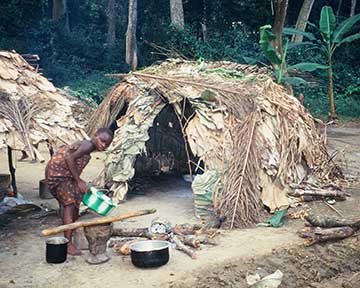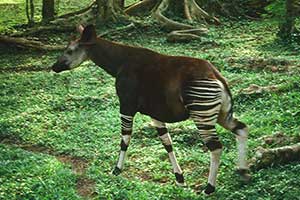 Ituri Rain Forest, Pygmies and Okapi
Ituri Rain Forest, Pygmies and Okapi
January 28, 1988
In the heart of the Ituri Forest, in the deepest darkest jungle, there is an American-style campground with a mowed lawn, lovely little log buildings, terraces and even outhouses. Nearby is one of the last remaining Pygmy villages, and an okapi—a beautifully marked animal that has never been seen in the wild. It lives in the deep jungle and silently slips away whenever people or predators are nearby.
We saw the okapi in captivity. Our guide was a zookeeper from America, a highly talented young man researching the species and working to preserve its habitat. The animal me saw was destined for a zoo.
 The Pygmies help trap okapi and collect leaves to feed them. They do not hunt them, preferring the smaller dik-dik for food (a dik-dik is an antelope about the size of a rabbit). The American collected a small fee for taking us to the Pygmy village to take pictures, and told us the money is used to give the Pygmies a weekly feast in return for them allowing tourists to visit their village.
The Pygmies help trap okapi and collect leaves to feed them. They do not hunt them, preferring the smaller dik-dik for food (a dik-dik is an antelope about the size of a rabbit). The American collected a small fee for taking us to the Pygmy village to take pictures, and told us the money is used to give the Pygmies a weekly feast in return for them allowing tourists to visit their village.
A few days earlier, Dennis had seen Pygmies on the forest road, naked and painted white, laughing, dancing, and waving bows and arrows. The American told us they had likely been on their way to a wedding.
 We visited the village on an ordinary day, and as we walked in, the people looked at us with dour expressions, then looked away and continued with their work—pounding leaves, cooking and carving. Children begged for cigarettes and I saw a child that looked to be no more than three years old smoking! A man brought out some authentic bows and arrows to sell. Dennis and I each bought one for $4.00.
We visited the village on an ordinary day, and as we walked in, the people looked at us with dour expressions, then looked away and continued with their work—pounding leaves, cooking and carving. Children begged for cigarettes and I saw a child that looked to be no more than three years old smoking! A man brought out some authentic bows and arrows to sell. Dennis and I each bought one for $4.00.
The huts and lives of the Pygmies are simple and basic. They are aboriginal Africans, one of the two oldest known human groups on the continent. They are generally nomadic and live essentially the same today as they did several thousand years ago. These days, however, they are familiar with plastic, Coca Cola, and tourists.
Go on to Mountain Gorillas
Source: www.SusanCAnthony.com, ©Susan C. Anthony
